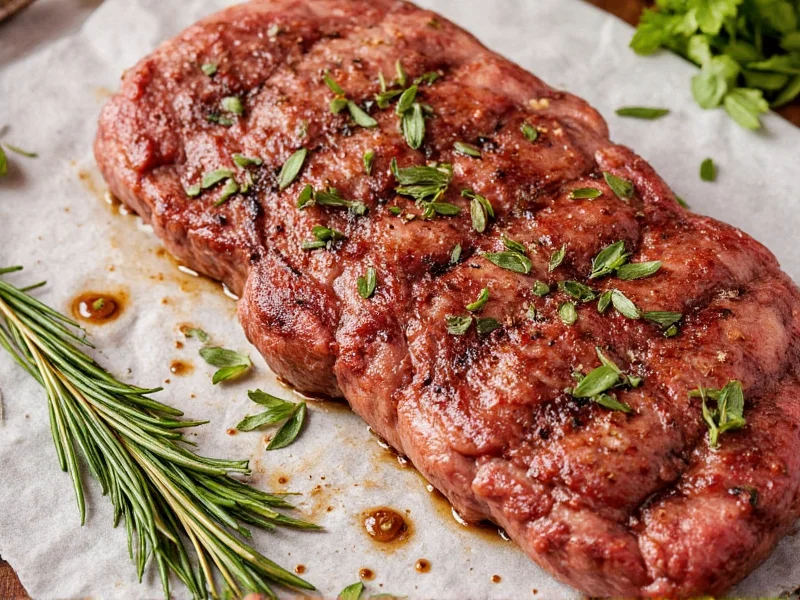Choosing the right herbs can transform your steak from ordinary to extraordinary. While steak's rich, savory flavor stands well on its own, the proper herb selection enhances its natural qualities without overwhelming them. Understanding which herbs work best with different cuts and cooking methods makes all the difference in your final dish.
Classic Herb Pairings for Steak
When considering what herbs to put on steak, certain classics have stood the test of time for good reason. These herbs naturally complement beef's umami-rich profile:
Rosemary: The Steakhouse Essential
Rosemary's pine-like aroma and robust flavor make it arguably the most popular herb for steak. Its woody notes pair exceptionally well with grilled ribeyes and New York strips. When cooking steak with rosemary, try these techniques:
- Crush fresh rosemary sprigs and rub directly onto the steak before cooking
- Add whole sprigs to hot coals when grilling for aromatic smoke infusion
- Create a rosemary-garlic compound butter for finishing cooked steaks
The secret to using rosemary successfully is moderation—it's potent, so a little goes a long way. For best results with ribeye steak, combine rosemary with just garlic and black pepper.
Thyme: The Versatile Companion
Thyme's subtle earthiness works beautifully across nearly all steak cuts. Unlike more aggressive herbs, thyme enhances without dominating. French chefs often use herbes de Provence (which contains thyme) for steak preparation. When using thyme for grilled steak:
- Strip leaves from stems and mix with olive oil to create a paste
- Add to pan during the last few minutes of cooking for seared steaks
- Combine with oregano for Mediterranean-style steak preparations
Garlic: The Universal Enhancer
Though technically an allium rather than an herb, garlic deserves mention in any discussion about steak seasonings. Its pungent, sweet flavor when cooked complements beef perfectly. For optimal garlic infusion:
- Use whole cloves rather than minced garlic to prevent burning
- Add during the last 5 minutes of cooking for grilled steak
- Infuse olive oil with garlic for herb marinades
| Steak Cut | Recommended Herbs | Preparation Tip |
|---|---|---|
| Ribeye | Rosemary, thyme, garlic | Press crushed herbs into fat cap before searing |
| Filet Mignon | Tarragon, chives, parsley | Use lighter herbs to complement delicate flavor |
| New York Strip | Oregano, sage, rosemary | Create herb crust by pressing into meat surface |
| Skirt Steak | Cilantro, oregano, cumin | Marinate with herbs for 2-4 hours before grilling |
| Flank Steak | Rosemary, thyme, garlic | Score meat and insert herb paste before cooking |
Fresh vs. Dried Herbs for Steak
Understanding the difference between fresh and dried herbs significantly impacts your steak's final flavor profile. Many home cooks make the mistake of using them interchangeably without adjusting quantities.
Fresh herbs generally provide brighter, more complex flavors and work best:
- When rubbed directly onto steak before cooking
- As finishing elements after cooking
- In compound butters for melted herb infusion
Dried herbs offer concentrated flavor and excel when:
- Creating dry rubs (use ⅓ the amount of fresh)
- Combined with oil to form a paste
- Added early in cooking for tougher cuts that need longer preparation
For most steak preparations, fresh herbs deliver superior results. The only exception is when creating dry rubs for thicker cuts like tomahawk steaks, where dried herbs penetrate more effectively.
Advanced Herb Techniques for Perfect Steak
Once you've mastered basic herb selection for steak, these professional techniques will elevate your results:
Herb Oil Infusions
Create custom herb oils by gently heating olive oil with your chosen herbs (no more than 2-3 types) for 10-15 minutes. Strain and use to brush steaks during the last few minutes of cooking. This method prevents herbs from burning while delivering intense flavor.
Herb Butter Finishes
No discussion of what herbs to put on steak would be complete without mentioning compound butter. After cooking, place a pat of herb butter (chilled butter mixed with finely chopped herbs, garlic, and lemon zest) on top of your steak. As it melts, it creates an instant sauce that enhances without overwhelming.
Timing Matters: When to Add Herbs
The timing of herb application dramatically affects flavor development:
- Before cooking: Rub herbs into the surface for deeper flavor penetration (best with heartier herbs like rosemary and thyme)
- During cooking: Add delicate herbs like parsley or chives in the last 2-3 minutes to preserve their bright flavor
- After cooking: Finish with fresh herb garnishes for aromatic complexity without cooking off volatile oils
Avoiding Common Herb Mistakes with Steak
Even experienced cooks make these herb-related errors when preparing steak:
- Overpowering the meat: Using too many different herbs creates flavor confusion. Stick to 2-3 complementary herbs maximum.
- Burning delicate herbs: Adding herbs too early in high-heat cooking causes bitterness. Reserve delicate herbs for finishing.
- Ignoring cut-specific needs: Filet mignon requires lighter herb treatment than robust cuts like ribeye.
- Using dried herbs incorrectly: Dried herbs need oil or moisture to rehydrate properly—don't just sprinkle them dry on steak.
Creative Herb Variations for Different Palates
While classic herb combinations work reliably, these creative pairings offer exciting alternatives for adventurous cooks:
- Mediterranean twist: Oregano, thyme, and lemon zest for grilled flank steak
- French bistro style: Tarragon, chives, and parsley for filet mignon
- Southwest flair: Cilantro, oregano, and smoked paprika for skirt steak
- Umami boost: Rosemary, sage, and a touch of dried porcini mushroom powder
Remember that the best herbs for steak ultimately depend on your personal taste preferences and the specific cut you're preparing. Experiment with different combinations to discover your perfect match, always keeping in mind that the goal is to enhance—not mask—the natural flavor of quality beef.











 浙公网安备
33010002000092号
浙公网安备
33010002000092号 浙B2-20120091-4
浙B2-20120091-4